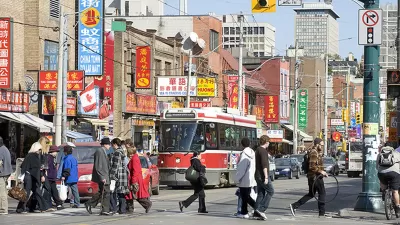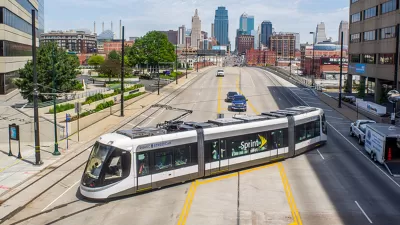A tough first week for the new LYNX Gold streetcar line in Charlotte inspired a review of the current research about the value of streetcars.

Andrew Keatts provides a recap of a tumultuous, unfortunate first week of operation for the Charlotte Streetcar. A few examples:
- "One streetcar crashed into an SUV after its driver lost control of its vehicle, city officials said."
- "A reporter laced up her sneakers and raced the streetcar, beating it to the end of the 1.4-mile line by a full two minutes."
Those hiccups indicate why, according to Keatts, the debate about the value of streetcars has persisted even as more and more cities roll out new streetcar projects. In fact, says Keatts, more and more academics are reaching consensus that streetcar lines do not make a wise investment.
Central to the challenges encountered by streetcars, however, are the sacrifices made in planning stages. Charlotte's new streetcar, for example, does not have a dedicated line and runs on 15-miniute headways during peak periods—not exactly the best model for frequent, reliable service.
The article goes on took a closer look at the emerging body of research, with special attention to the work of Jeff Brown, chair of the Department of Urban & Regional Planning at Florida State University. To summarize, Keatts writes: "A key point of emphasis among all the academic skeptics of the modern streetcar projects is that there isn’t anything inherently wrong with streetcars. The problem is with the way they’re executed."
FULL STORY: A streetcar named disaster? Debate ensues as latest project debuts

Planetizen Federal Action Tracker
A weekly monitor of how Trump’s orders and actions are impacting planners and planning in America.

Congressman Proposes Bill to Rename DC Metro “Trump Train”
The Make Autorail Great Again Act would withhold federal funding to the system until the Washington Metropolitan Area Transit Authority (WMATA), rebrands as the Washington Metropolitan Authority for Greater Access (WMAGA).

DARTSpace Platform Streamlines Dallas TOD Application Process
The Dallas transit agency hopes a shorter permitting timeline will boost transit-oriented development around rail stations.

DC, Columbus Bike Share Fleets Introduce Cargo Bikes
Shared mobility is ‘growing up,’ with rental options increasingly expanding to include e-bikes, scooters, and cargo bikes.

Five Key Transportation Funding Proposals in Trump’s Budget
The President’s proposed 2026 budget would keep spending roughly the same for transit and rail and eliminate over $5 billion in funding for EV charging infrastructure.

LA County Creating Action Plan to Tackle Extreme Heat
Los Angeles County is creating a Heat Action Plan to help communities stay safe during extreme heat, with steps like adding more shade, improving buildings, and supporting the neighborhoods most at risk.
Urban Design for Planners 1: Software Tools
This six-course series explores essential urban design concepts using open source software and equips planners with the tools they need to participate fully in the urban design process.
Planning for Universal Design
Learn the tools for implementing Universal Design in planning regulations.
City of Charlotte
Municipality of Princeton
Roanoke Valley-Alleghany Regional Commission
City of Camden Redevelopment Agency
City of Astoria
Transportation Research & Education Center (TREC) at Portland State University
US High Speed Rail Association
City of Camden Redevelopment Agency
Municipality of Princeton (NJ)



























